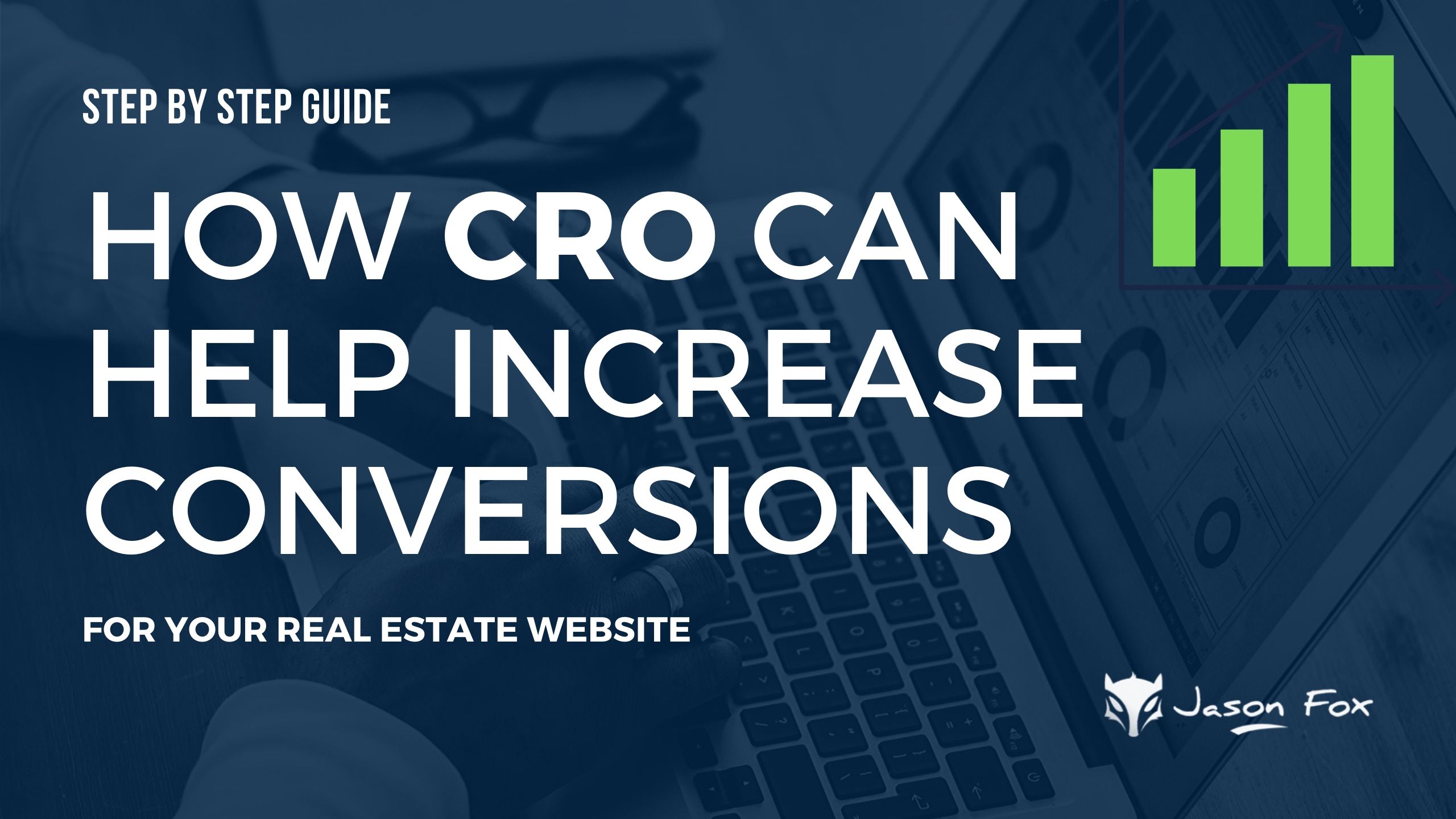CRO, or conversion rate optimization, is becoming more important as businesses compete for customer attention. Businesses that hone in on CRO and make it a priority benefit from spikes in sales and client interaction.
Conversion rate optimization (CRO) is the systematic process of increasing the percentage of website visitors who take a desired action — be that filling out a form, becoming customers, or otherwise. The CRO process involves understanding how users move through your site, what actions they take, and what’s stopping them from completing your goals. (Moz)
In real estate, building a website with CRO is critical; buyers, sellers, property managers, and everyone else involved will visit tons of websites to decide which agency is right for them. Choosing to invest time and energy into CRO for your agency increases the chance that these potential clients will choose you for their real estate needs.
So, what can you do to ensure your brand stands out against the competition?
Here’s a step-by-step guide on using CRO to increase conversions for your real estate website.
How to A/B Test Your Real Estate Website
Step 1: Learn about A/B Testing
According to the Harvard Business Review, A/B testing is the process of creating two or more versions of something and testing them against each other to see which one is more successful. When you A/B test your website, you test two versions of your site with visitors and learn which one is more appealing.
“Success” is measured by whether a site visitor takes a desired action, such as buying a product or service. For real estate, the desired action is getting the site visitor to contact the realtor for more information.
A/B testing goes a bit like this:
-
- Select an element of the website that you’d like to test, such as a CTA (call-to-action) button or a header
- Make the change that you think will increase the number of conversions from the site
- Test the new version of the site by sending half of the traffic to the original version and half to the new version
- Measure which page converts more site visitors
- Implement the changes of the winning site
- Repeat the process with other elements of the site
Step 2: Know What To A/B Test
So you know what A/B testing is, but you don’t know what to test. You can test almost every element on your website, from a simple header to the entire page. However, smaller changes are better to start with, so you can work outward from there.
The most important element of a real estate site is the CTA (call to action). CTAs are usually ignored when it comes to A/B testing because we assume it’s the body of the page that matters most. The CTA should be clear, convincing, and concise so that someone visiting your site sees it and immediately wants to click.
Other things you can A/B test include:
-
- Headings
- Subheadings
- Text
- Images
However, in the world of real estate, the CTA is the #1 thing you need to get right on your website. Changing and testing different CTA options will help you understand what drives conversions.
Step 3: Setting Up Your A/B Test
There are professional services that can perform various CRO services like A/B testing for you. This is the easiest way to get your CRO done efficiently and successfully. However, if you plan on doing the A/B testing yourself, here are the essentials for success:
Define Goals
Knowing what the goal is of an A/B test can help you know whether it was successful or not. Defining goals always reminds you of the purpose for testing.
The main goal is, of course, to convert the site visitor into a potential real estate client via the CTA. A secondary goal could be to increase site traffic and visibility by using SEO strategies.
Utilize Unique SEO
SEO, or search engine optimization, is the manipulation of keywords, headers, meta descriptions, and other word elements on a webpage to appear higher up in search engine results. Testing different SEO elements against each other during A/B testing gives you an idea of what search engines return to people who are searching for your service.
There are many SEO strategies that work specifically for real estate agencies. A search for “Real estate company” will return millions of results, but making your page unique to your area and level of real estate expertise will make your page more relevant to those who need it.
Track Everything
Tracking CTA clicks are important, but for the best results, you will need to track how every element on the site performs.
For example, say you’re testing out four different CTA’s that you theorize will convert site visitors into potential clients. The most successful CTA will convert the most site visitors, but it could come at the cost of decreasing the amount of other clicks on the page.
Track CTA clicks, but also make sure to track page visits, form submits, clicks on elements (menus, buttons, images), and potentially revenue from product links.
Step 4: Managing the Test and Results
Once you’ve gathered enough data, you can generate reports of your A/B testing results. One example of this is a report that shows which variation of your site has the most clickthroughs or conversions. Here are some things to remember when looking at the results of an A/B test:
-
- Don’t call a winner too early. You want 95% certainty or more.
- Focus on what matters most. In real estate, you’ll need to know which CTA makes the most conversions
- Don’t test too many items at once. Keep it simple at first, then test more when you’re sure of what you’re doing.
- Remember what your goals are. Don’t go into the process without a hypothesis and a goal to accomplish.
As said before, this entire process can be overwhelming for those new to CRO, but A/B testing brings results. Real estate is a tedious business, especially when trying to convert people into clients, but putting in some work with CRO will make a difference.
4 CRO Mistakes to Avoid When Dealing With Real Estate
The stakes are high in the world of real estate: losing a client can mean losing thousands (sometimes millions) of dollars. Here are some mistakes to avoid when dealing with real estate CRO.
Changing The Site Without Testing
Switching elements of a website will not automatically result in more traffic or conversions. A/B testing is essential to learn which elements of the site are working and which are not.
Testing Multiple Versions Simultaneously
It can be tempting to test more than one element of your site at a time, but this can make it difficult to know which change is affecting the conversion rate.
For example, say you’re testing one landing page with a photo of a condo against another landing page with a photo of an apartment. If you also want to change the header for the landing page, you won’t know if the photo or the header is changing the conversion rate of the site.
Copying Competitors
Although all real estate websites focus on selling properties, they should all be unique. Since the real estate market is huge, visitors to your site will likely have also been to dozens of other real estate sites.
Making your site stand out among the competition will help visitors remember you and want to know more about your real estate business. Otherwise, your site’s visuals will blend in with the competition, and they’ll forget you.
Ineffective Targeting
Effective targeting is important to get the right people to your website. This involves using SEO to target the right demographics and geography for your business. Target users with ads, email campaigns, and SEO to get the relevant audience to visit your site.
4 Must-Do’s for Real Estate CRO
Good CRO is essential to make your real estate business generate leads and stand out among the competition. Remember these key takeaways, apply them, and watch your real estate website thrive.
- Make your landing page and search tools simple and easy to use. People buying or selling a property don’t want to read a book of text. The copy and design of your site should be simple and relevant.
- Use stunning imagery. With real estate, a picture is worth a thousand words. Anyone can post photos of a house with their smartphone, but high-quality images intrigue visitors and evoke emotion, which almost always leads to action.
- Be direct with your verbiage. Fluff and false promises on the website can lead to bad reviews and mistrust. Be direct, and don’t withhold important details for properties.
- Personalize the experience. General pages can include general information about properties, but people are more likely to get in touch with you if you offer a survey about where they’d like to live or what they’re interested in.
Final Thoughts
Your website is your real estate lead generation hub. Using CRO to increase traffic and convert visitors can help you sell more properties and make your business flourish.
A/B testing is essential for real estate CRO because it allows you to see what converts visitors to clients and what doesn’t. If you are having trouble with CRO for your real estate website, enlist the help of a professional digital marketing firm. CRO experts will learn about your business and help you test for the best results.








Leave A Comment